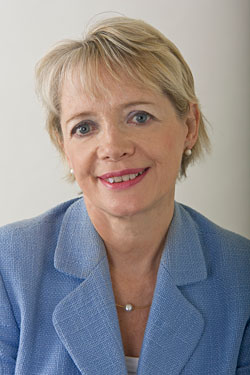Short courses help women get on board

Simply sign up to the Business education myFT Digest -- delivered directly to your inbox.
Susan Vinnicombe is exasperated. The professor of women and leadership at Cranfield School of Management in the UK is tired of hearing that women lack the confidence to make it to the very top.
“Women do not lack confidence. I get angry when I see it framed in that way. What they lack is leadership self-efficacy,” she says.
This lack of belief in their suitability for specific senior leadership roles – and reluctance to put themselves forward for them – is what many business schools are trying to address with their provision of training for women on boards.
There is a tangible sense that things are on the move. More than 10 years have passed since Norway made waves with the introduction of an ambitious mandatory quota of 40 per cent for women on the boards of its largest companies. While its move sparked furious debate, Norway has also gained quite a few imitators, especially in Europe where a 40 per cent quota has been proposed for the whole of the European Union.
“Europe continues to be a leader on this issue,” writes law firm Paul Hastings in its annual report on this issue: Breaking the Glass Ceiling: Women in the Boardroom. “2013 showed the highest year-on-year change recorded to date in the average number of women on boards of large corporations in EU member states.”
Its latest report, published in September last year, also notes increasing activity elsewhere in the world. By 2013 more than 50 cities in mainland China had adopted local rules implementing 2011 legislation requiring an increase in representation of women on boards of public and private companies.
India was also addressing the issue with legislation, while Australia and New Zealand had adopted reporting requirements on gender parity. And even in the US and Canada, where there was only marginal growth in the percentage of women on company boards, the issue was more often being discussed.

It is no surprise that the past few years have seen a flurry of new programmes being offered by business schools aimed at preparing women for being on boards. One of the newest is Duke Corporate Education’s Women Leading Africa.
It is a five-day programme which launches in Namibia this month but will also be run in Kenya and South Africa in June. The experiential course will feature structures such as a simulated board room, an audit committee and a social and ethics committee. It starts in Namibia because the country has adopted a 50 per cent quota for women on boards, says Sharmla Chetty, regional managing director for Africa for Duke CE. Its partner in delivering the course will be Namibia’s 50% Club.
“This is being driven at a government level,” explains Christine Robers, director of marketing for Duke CE.
Also about to launch is Wharton’s Women’s Executive Leadership: Business Strategies for Success, a five-day programme that will run in July.
“This is something we thought about for a long time,” explains Nancy Rothbard, professor of management at Wharton in Philadelphia. “We felt that now it’s the right time, because there seems to be some kind of momentum around these issues.”
Ruth Sacks, a senior lecturer at Westminster Business School in the UK, is also testing the waters.
Women for the Board, a six-day course aimed at women who are no more than two steps away from the board, is in its inaugural year.
She says the decision to launch the course was partly inspired by the 2011 release of the UK’s first government-sponsored report called Women on Boards by Lord Davies.
The report led to the UK’s adoption of a target for female representation on boards but also noted that barriers prevented women from rising to the highest ranks in business.
Sacks says her marketing activities for Westminster Business School had also revealed a need. “I asked women who are on boards what they wished they had known and that is where the course came from.”
Incae Business School, whose main campuses are in Costa Rica and Nicaragua, launched its Women’s Executive Leadership Programme in December 2013 and is marketing the course, which runs at its Miami hub, to women across Latin America.
All this must seem like old hat to Prof Vinnicombe. “I was probably one of the first. I have been running this for 25 years,” she says of Cranfield’s Women as Leaders Programme.
Like the more recent programmes dedicated to improving women’s chances of getting on to boards, Women as Leaders is a women-only course.
“A lot of women do feel ambivalent about coming on a women-only course,” says Prof Vinnicombe, but she adds that they do appreciate it afterwards.
Nuria Chinchilla, professor of managing people in organisations at Iese in Spain, also canvasses women on whether they want to be trained in a single-sex environment before they begin the Mujeres en Consejos de Administración, a women-only executive training course, in Spanish, that launched three years ago.
Prof Chinchilla says she can get more done more quickly if no men are present.
“At the end of every session I ask them, would you have preferred to be in a mixed session or not. Usually, only one or two say so at the end, although a larger group voice that preference at the beginning.”
While business schools have obviously spotted an opportunity in providing dedicated programmes to help more women get on to boards, some think women should participate in general leadership and board programmes with men because it more closely mimics the real world.
Ludo Van der Heyden, who heads Insead’s International Directors Programme, says: “I think you have to train people in their real environments. If you want people on boards you need to train women with men.”
He says about 10 per cent of programme participants were women when he started running it in 2011. About a third of the latest cohort of 40 participants are women.
“Research shows that women are over-mentored but under-sponsored. So this is the big frustration for women,” Prof Van der Heyden says.
“They go to courses. They network, but if people are not going to sponsor them, they will not succeed.”
Jim Westphal, chair of strategy of the Ross School of Business in Michigan, which does not at present offer any women-only executive training courses, agrees. He thinks business schools have a role to play educating boards in general so that male members see the value in appointing more women.
“There needs to be more training on what is effective decision making on boards,” he says, adding that an efficient board should be representative of a company’s market.
Board members, he believes, should be selected for their expertise and then it should be ensured that they all have equal influence on decision making.
There has been a lot of progress, but there is clearly a long way to go.
“Most of these women on the level that we’re working at are working in male-dominated environments and they begin to wonder if the reason they are not being promoted is because they’re a woman,” says Cranfield’s Prof Vinnicombe.
But Prof Van der Heyden believes there is no excuse: “I’ve never met a board that was looking for a female director that couldn’t find a good one.”
Comments